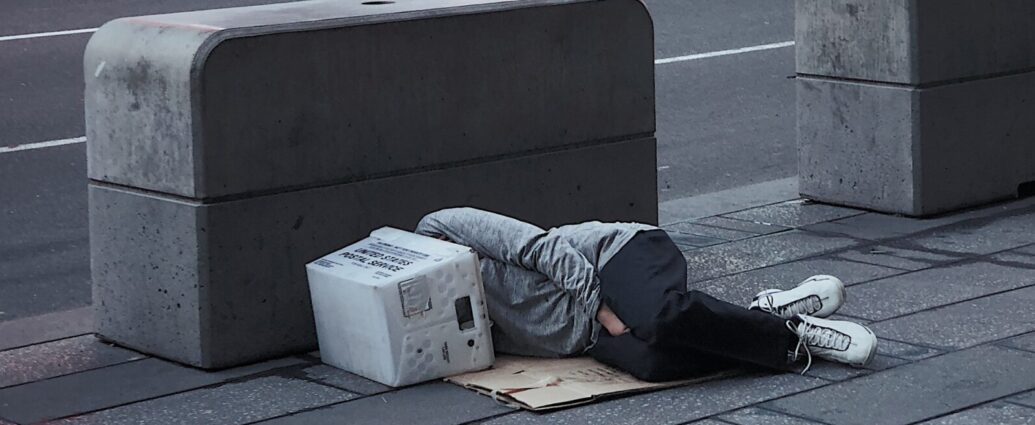Katie Nelmes
Can you remember a time when you have been out in public and seen a cluster of metal spikes on the pavement? Or a time when you have struggled to find a comfortable place to sit? This is not accidental, this is anti-homeless architecture.
What is anti-homeless architecture?
Anti-homeless architecture can be described as defensive, hostile, or exclusionary design. These terms underpin the notion that our cities are built to exclude certain types of people. The supposed intention behind these hostile structures is to prevent crime and anti-social behaviour, but such planning is not without other negative side effects.
Examples of 'Anti-Homeless' Hostile Architecture That You Probably Never Noticed Before. Your city would rather spend the money on anything “but” helping the people in need….. THREAD 👇🏾 pic.twitter.com/WLbOnMVqs3
— Kenny Akers (@KeneAkers) January 20, 2023
Sometimes, anti-homeless architecture can take the form of armrests on benches, preventing people from lying down. There are also examples of spikes under bridges, only there to stop individuals using them for shelter. Even street dividers, like potted plants and gaps in awnings, are obstacles to thwart those seeking a comfortable place to rest.
In some cases, it is the absence of architecture that becomes hostile. One New York subway station admitted to removing benches altogether, in efforts to block homeless people from sleeping on them.
Who does it impact?
Hostile architecture makes life more difficult for those with no choice but to live on the streets. Without homes to go to and holding fears about safety in hostels, many homeless people opt to live on the streets instead. But with exclusionary design, the lack of comfort and compassion shown to the most vulnerable among us becomes all the more draconian.
And it is not just homeless people who are impacted. Hostile design also causes problems for disabled people, who may find it more difficult to find somewhere to rest. How often have you been at a bus stop or a train station, looking for a seat, only to find cartoonishly thin, slanted benches? Fit for a quick perch but unsuitable for a meaningful rest.
Uneven surfaces, including rocky pavements and spikes, can be dangerous to visually impaired people. Those in wheelchairs or mobility scooters are also affected. The decision to install outdoor furniture not fit for purpose makes it trickier for disabled people to use public spaces and is a prime example of ableism.
Why is it a problem?
Supporters argue that hostile architecture is beneficial to the extent that it limits anti-social behaviour. Bench dividers and other contraptions also allow people to maintain personal space and social distance.
Not all examples of hostile architecture intend to cause harm. For example, the introduction of metal spikes outside Selfridges was supposed to “reduce litter and smoking… following customer complaints.”
Some suggest that architecture is a design choice. Curved benches and other unique structures are placed in city centres for aesthetic purposes. They can even be used for advertising, as recently seen for the Barbie movie.
love how the Barbie bench still has anti-homeless, hostile architecture armrests below a pic of Ken doing exactly what they're designed to prevent.
LOL SO CUTE!!! https://t.co/I09NBrymrk
— Rik Godwin (@Tafdolphin) June 27, 2023
Others suggest designs such as these have a deliberate effect. Anti anti-homeless spikes campaigners have suggested that hostile architecture creates a sense of “othering”, as it sends a clear message about who does and doesn’t belong in public spaces.
The purpose of this kind of architecture is to create a sanitised image of towns and cities, hiding anyone who doesn’t fit this idealisation. Rough sleepers are pushed to the margins of society, unseen and unacknowledged.
Anti-homeless architecture increases the stigma held against people already facing huge levels of discrimination. Hostile environments do nothing to help homeless people. Instead, they become further marginalised and are forced to inhabit dangerous areas. Anti-homeless architecture is a physical embodiment of the phrase “out of sight, out of mind”.
How can we eliminate anti-homeless architecture?
If you want to fight against anti-homeless architecture, you can write to your local councils or political representatives, sign petitions, or inform your followers on social media. One Twitter account, Hostile Design, frequently posts photos of anti-homeless architecture from all over the world to spread awareness.
Montpelier, France pic.twitter.com/YJDapmO4Xx
— Hostile Design (@hostiledesign) July 26, 2023
In more extreme acts of resistance, activists have taken matters into their own hands. Owners of the Tumblr page Anti Anti-Homeless Spikes put a mattress on top of spikes in London to show that “regardless of whether you own, rent or even have a home, the streets are ours.”
Next time you’re heading into the city, taking a walk, or using public transport, have a look around for hostile architecture. You might be surprised by how many examples you can find.
READ NEXT:
-
CHRONIC PAIN IN YOUNG PEOPLE: ADDRESSING THE STIGMA
-
THOUSANDS OF AFGHAN REFUGEES THREATENED WITH HOMELESSNESS
-
CLOTHING POVERTY AWARENESS: THE UK’S CLOTHING POVERTY PROBLEM
Featured image courtesy of Jon Tyson on Unsplash. No changes made to this image. Image license found here.

